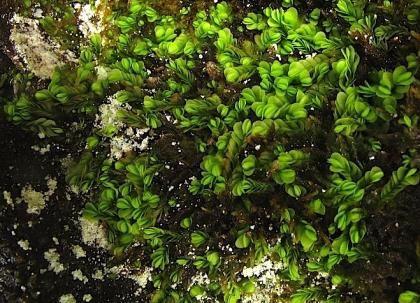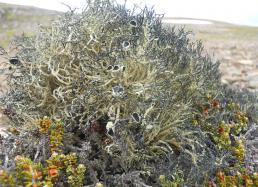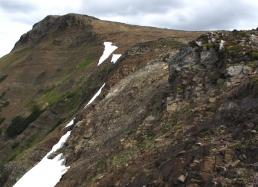Blog #6: Alpine Adaptations
This morning, Blanka and I left earlier than everyone to return to a site just outside of town that we had only briefly visited yesterday. In an area where a shallow river cut through banks of rich mineral soil, I had been REALLY excited to find Lethocolea, a beautiful liverwort that stands out in the field because it’s leaves are strongly opaque and a strange, matte yellow-green.
Lethocolea is in the same family of liverworts that I studied for my master’s thesis, but it's a plant that I’ve never seen before “in the wild.” In fact, it’s rare to find Lethocolea period—researchers may only see one plant in an entire environment, so my spotting it in the field is a real triumph.
Part of the reason the plant may be so scarce is its method of propagation. It seems to rely mostly on budding (producing an asexual “clone” of itself). Buds get picked up by wind and water and carried to a new location where they grow into a full-sized copy of the original plant.
But as we all know, clones don’t have the same chances of survival as offspring produced through sexual unions. Diseases or harsh weather conditions are likely to wipe out an entire cloned population because they lack the genetic variation that give some of the colony a chance of inheriting DNA that will help them survive a catastrophic event.
So you can see why I’m thrilled to have found Lethocolea yesterday, especially as I believe it may the first time this species has been cataloged in the area. Discovering new localities for a species is good news, because it helps us monitor populations and determine conservation factors. But since I could grab only a small collection of plants just as we were being called back to the vehicles, I was eager to spend more time here to see what else I could find.
While we were off surveying species, Ernesto was meeting with the Armada de Chile (Chilean Navy) to try and get permission for us to gain entry to our prospective collecting sites for the next week. These proposed locations include Islas Picton, Lennox, and Nueva—small islands historically littered with landmines because they’re very close to the border of Argentina. To my knowledge, some of these islands have never been botanically explored, and since they’re off-limits to touristic travel, Ernesto must convince the Navy of the importance of our scientific mission.
After his successful meeting, Ernesto picked us up, and we met the others in town to grab supplies for lunch: bread, cheese, drinkable yogurt, and most importantly, cookies. Then we headed for Cerro de Bandera (Flag Hill), where we hiked for a few hours up a well-traveled trail to reach the inspiration for this mountain's name—a giant Chilean flag flying just above the treeline.
After the obligatory photo session (see Photo #1 below), Blanka and I made a beeline straight for a small water track that we could see on the side of the mountain. Here above the treeline, everything changes and the liverwort diversity is astounding. So many alpine species, many of which we never see at lower elevations or in the forest (see Photo #2 below.)
The interesting thing about the plants living at this level is that they’re uniquely adapted to high-UV rays, cold temperatures, and strong winds (see photo #3 below.) The key to their success seems to be powerful chemical compounds, many of which are being studied for medicinal uses. By sampling and cataloging species—including for the first time some liverwort oil bodies—we can help identify new candidates for further research.
We spent several hours slowly working our way across rock outcrops and water tracks (see Photo #4 below) and were able to locate many more species on our list of collection priorities (see the “Beautiful Bryophytes” Photo Gallery for more photos and info.) I’d say it was one of the most satisfying days of collecting yet, made even better by knowing that this may have been my only shot to get above the treeline to such a nice alpine community.
More soon,
Laura









